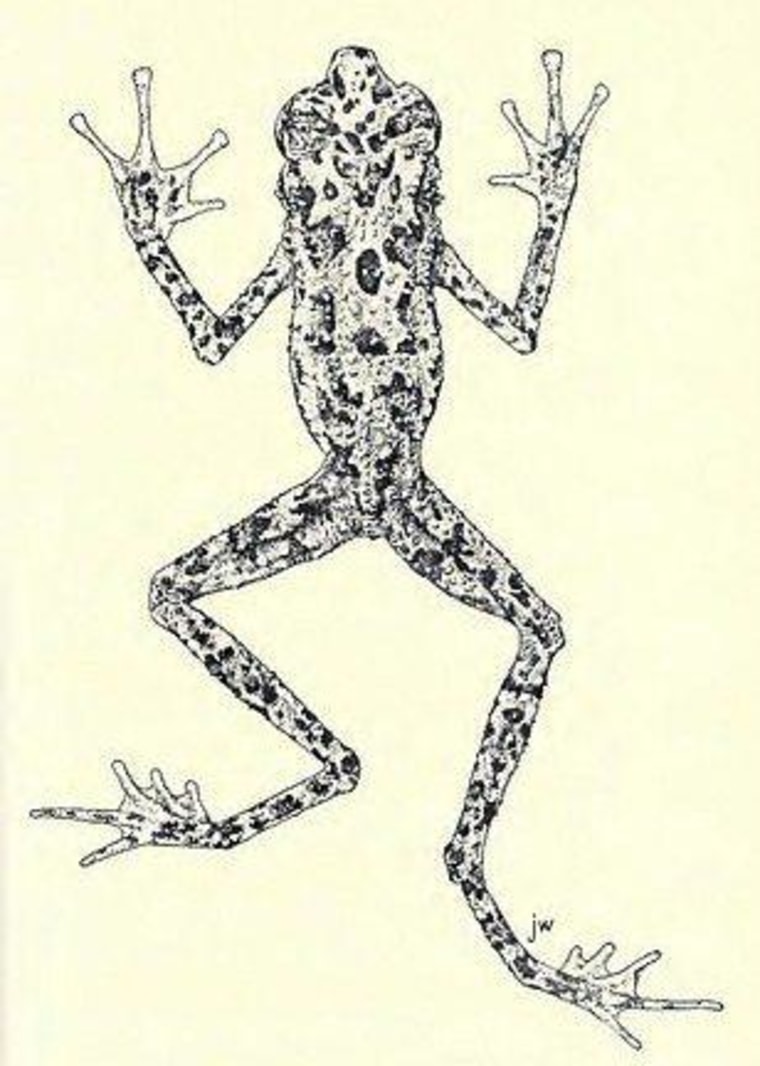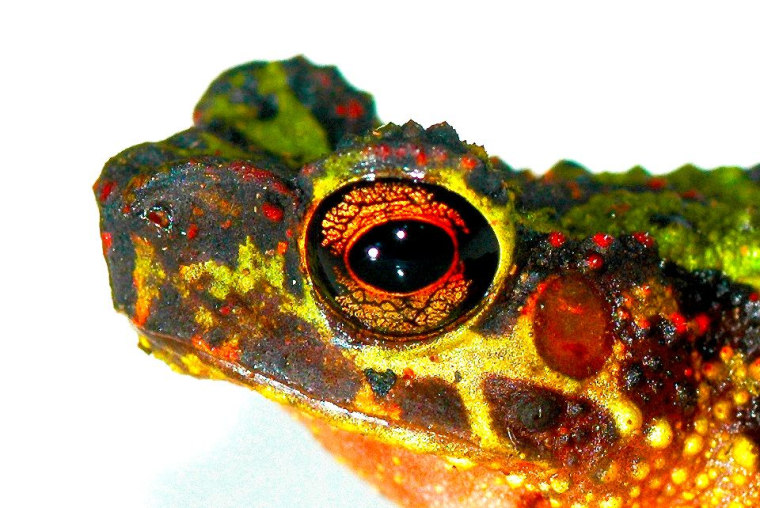Conservationists report that the Sambas Stream toad, one of their top 10 "lost" amphibian species, has been rediscovered in Malaysian Borneo 87 years after it was last sighted.
The find was made by scientists from Universiti Malaysia Sarawak who spent months looking for the toad in the remote Gunung Penrissen mountains of Western Sarawak, a natural boundary between Malaysia's Sarawak State and Indonesia's Kalimantan Barat Province on the island of Borneo. (Just writing those names makes me feel like Indiana Jones.)
Conservation International reports that the initial search was fruitless — so the expedition team, led by Indraneil Das, moved up to higher elevations and resumed the hunt. Eventually there came a night when one of Das' graduate students, Pui Yong Min, spotted a small toad sitting 6 feet (2 meters) up a tree.
Das could hardly believe what he was seeing.

"Thrilling discoveries like this beautiful toad, and the critical importance of amphibians to healthy ecosystems, are what fuel us to keep searching for lost species," Das said in a news release from Conservation International. "They remind us that nature still holds precious secrets that we are still uncovering, which is why targeted protection and conservation is so important. Amphibians are indicators of environmental health, with direct implications for human health. Their benefits to people should not be underestimated."
That's the whole idea behind the "Search for Lost Frogs" campaign, which was launched a year ago by Conservation International and the International Union for Conservation of Nature's SSC Amphibian Specialist Group. The groups drew up a "Ten Most Wanted" list in hopes of inspiring researchers to intensify the search for amphibians that have not been seen for decades.

The Sambas Stream toad is also known as the Bornean rainbow toad, with the scientific name Ansonia latidisca. The long-legged, multicolored toad was described by European explorers in the 1920s, and was last seen in 1924. Das' team identified three individuals — an adult female, an adult male and a juvenile, ranging in size from roughly an inch to 2 inches (30 to 51 millimeters).
Each of the toads was found in a different mature tree, in a region of the Penrissen range that's outside Sarawak's system of protected areas. The precise location is being kept secret in hopes of keeping pet collectors from going after the rainbow toads.
The toads are listed as endangered on the IUCN Red List, and Conservation International said they may be eligible for protection under Sarawak's wildlife ordinances.
Conservation International's Robin Moore, an expert on amphibians, said he was amazed to hear of the discovery.
"When I saw an email with the subject 'Ansonia latidisca found' pop into my in-box, I could barely believe my eyes," he said in the CI announcement. "Attached was an image — proof in the form of the first-ever photograph of the colorful and gangly tree-dwelling toad. The species was transformed in my mind from a black-and-white illustration to a living, colorful creature.”
Moore said he considered it a privilege to be among the first to see the pictures of the toad.
"It is good to know that nature can surprise us when we are close to giving up hope, especially amidst our planet’s escalating extinction crisis," he said. "Amphibians are at the forefront of this tragedy, so I hope that these unique species serve as flagships for conservation, inspiring pride and hope by Malaysians and people everywhere."
The rainbow frog is the second of the "Ten Most Wanted" amphibians to be rediscovered. The first was the Rio Pescado stubfoot toad (Atelopus balios), a species native to Ecuador that is critically endangered.
Two down, eight to go ... the search continues.
More species lost and found:
- Froggy finds raise hopes for Haiti
- Three new frogs leap into spotlight
- Amphibians wanted ... alive
- Biological gems found in Philippines
- Madagascar offers hundreds of new species
- Scientists spot biological beauties in Bali
- RAP stars rock the animal world
- New species from New Guinea
- Scientists finish first sea census
- Deep-sea creatures of the Coral Sea
- The top 10 new species from 2010
- Beautiful biodiversity in Brazil
- New Guinea's 'Lost World' revisited
- Indonesia's 'Garden of Eden'
- Papua New Guinea's new species
- Marine marvels from Papua New Guinea
- Biological treasures from Borneo
- Celebrities of the Celebes Sea
- 12 froggy finds from India
- Fantastic frogs from Colombia
- Aliens lurk in Antarctic depths
- The strange species of Suriname
- Vulnerable new species in Brazil
- Discoveries from Vietnam's 'Green Corridor'
- Endangered species of the Mekong Delta
- New species from Australia's coral reefs
- Thousands of new species in ocean's depths
- Hundreds of new species amid the Himalayas
- New species found Down Under ... underground
- Eight 'extinct' species found alive and kicking
Connect with the Cosmic Log community by "liking" the log's Facebook page or following @b0yle on Twitter. You can also add me to your Google+ circle, and check out "The Case for Pluto," my book about the controversial dwarf planet and the search for new worlds.
